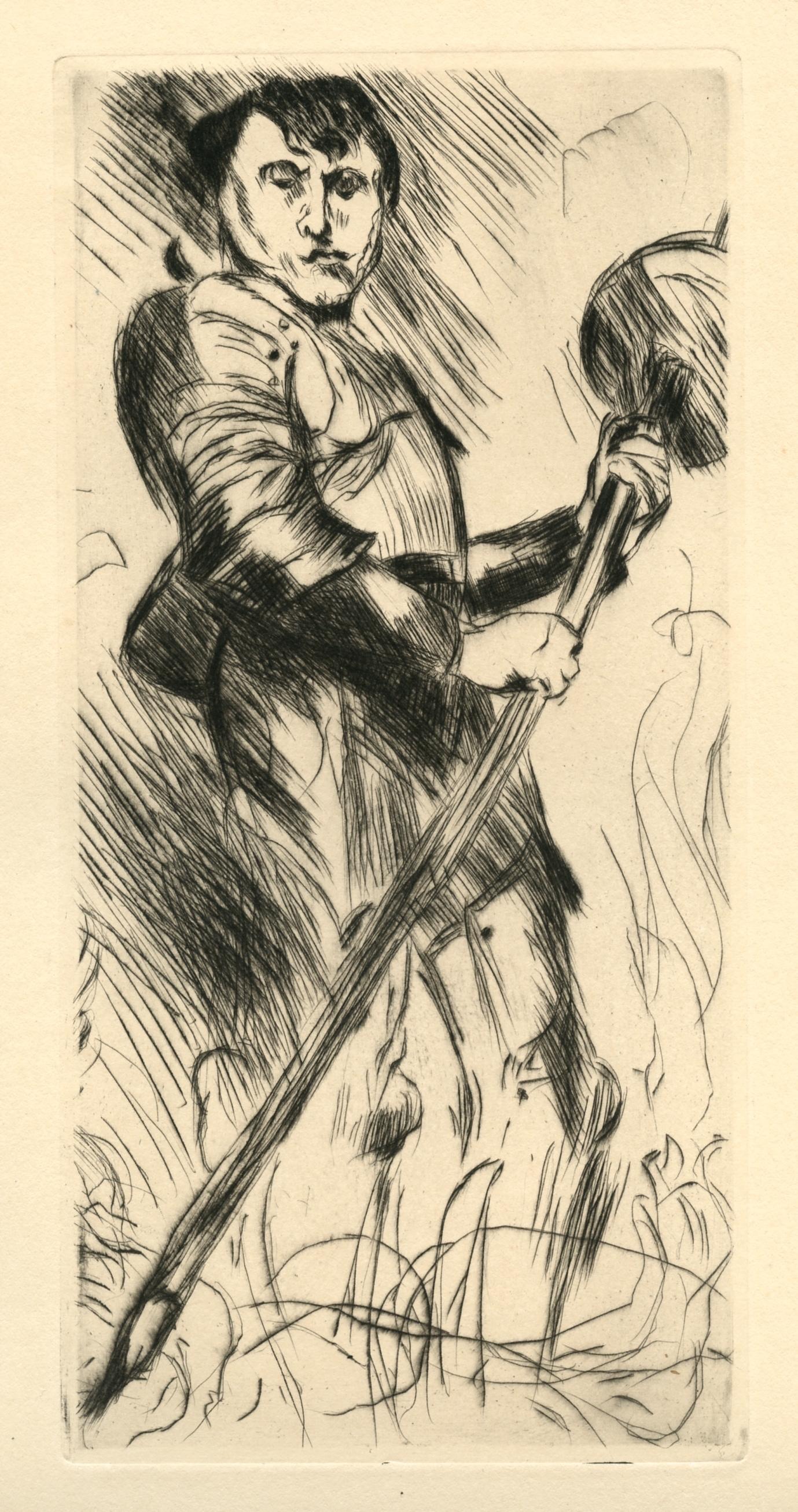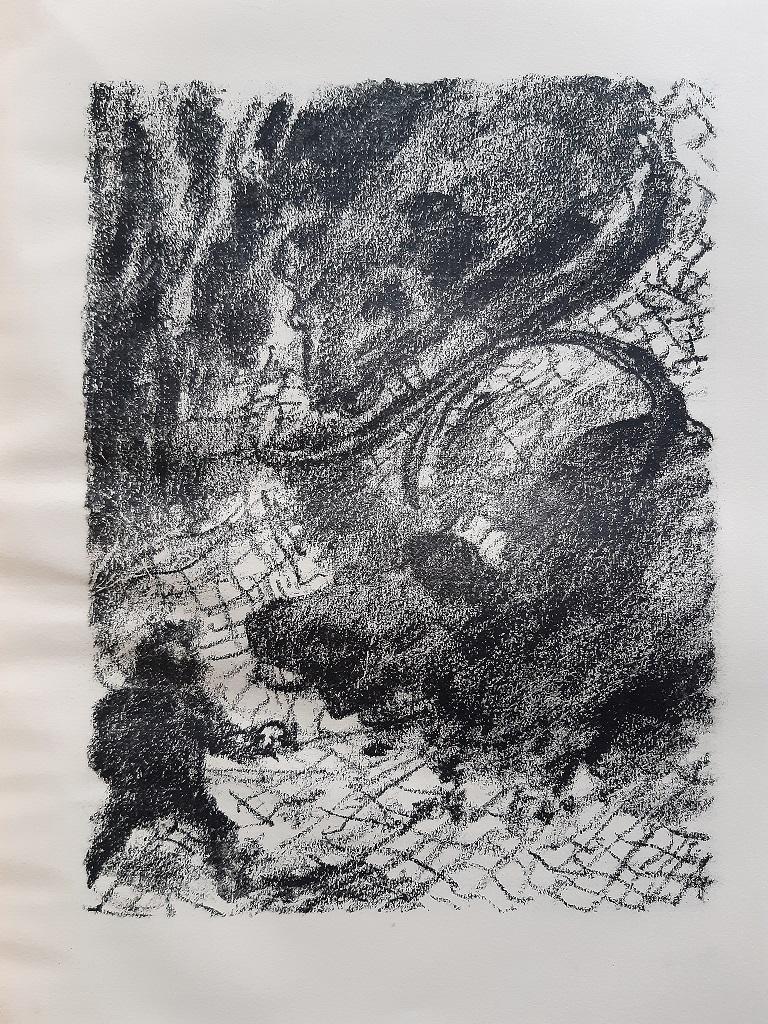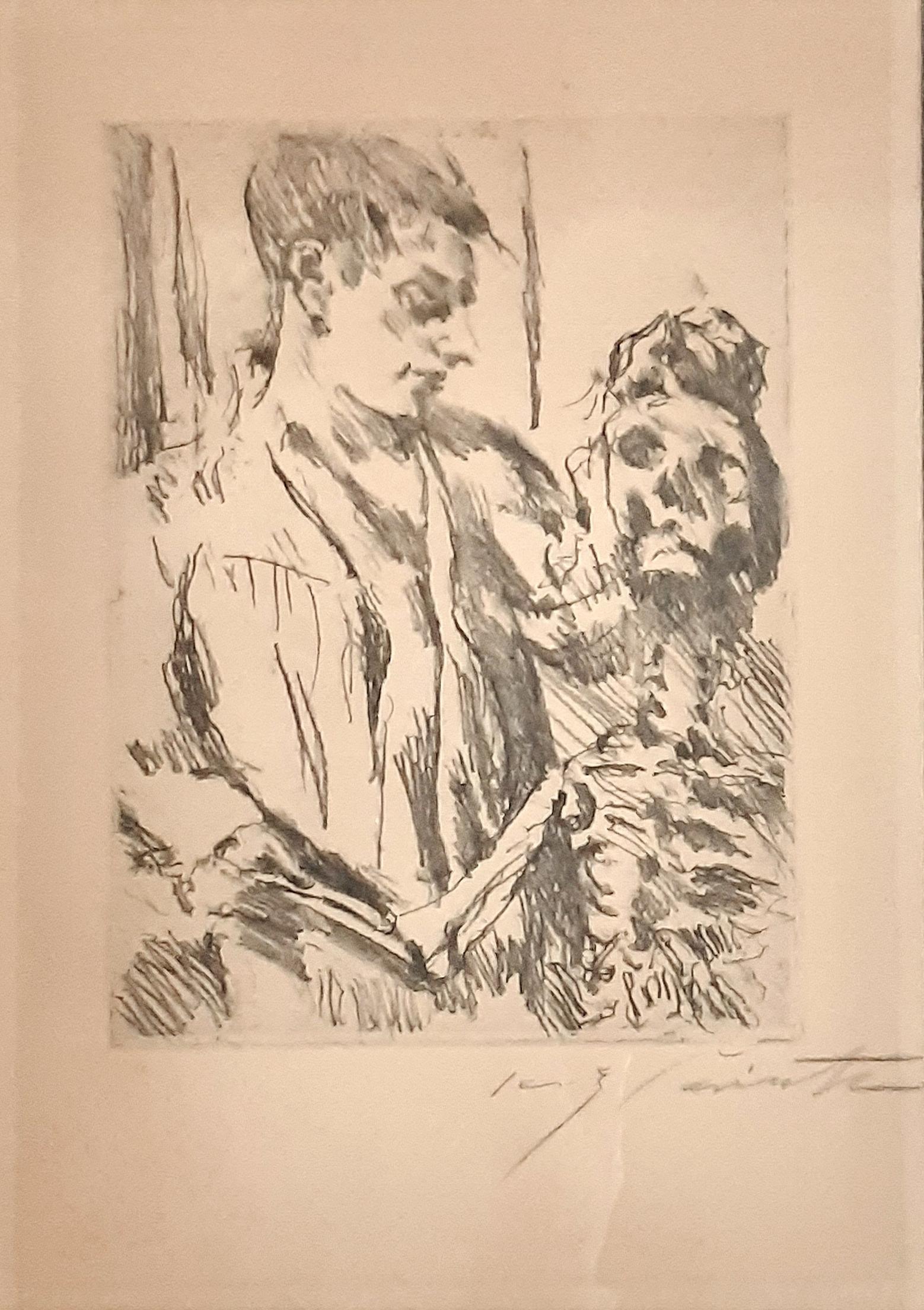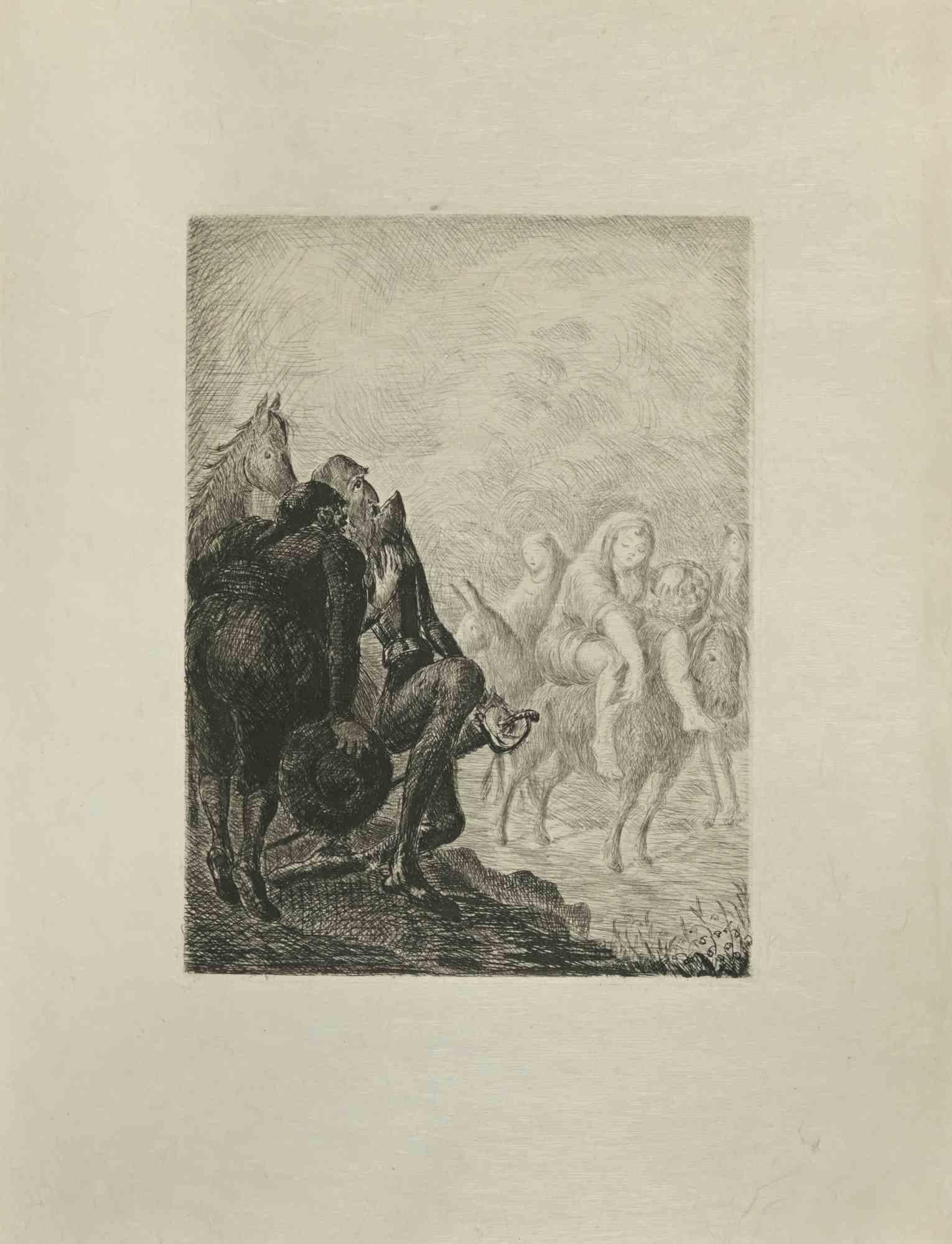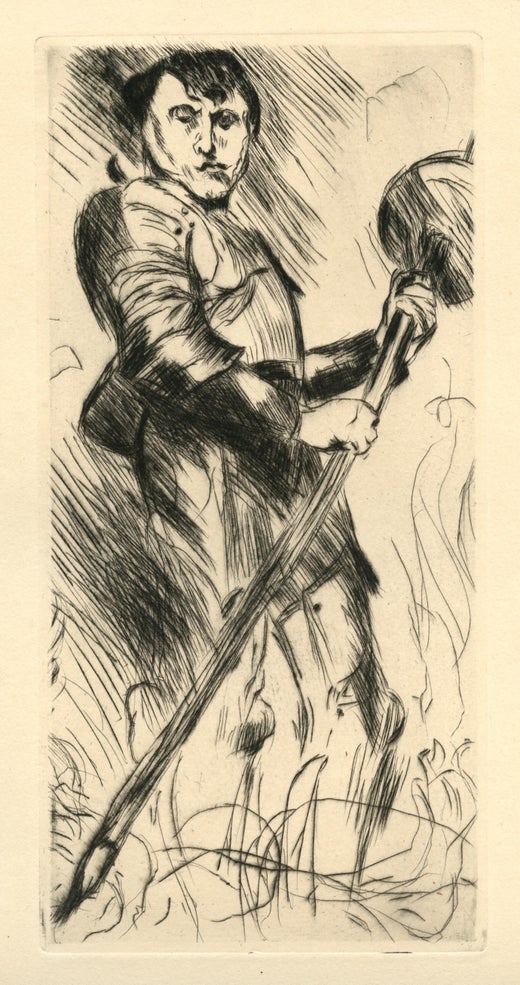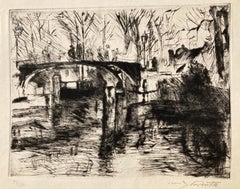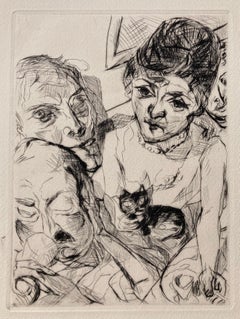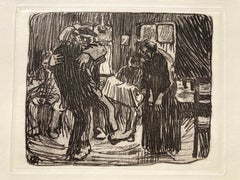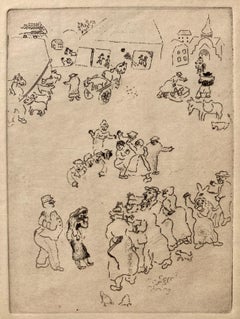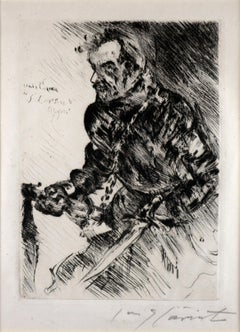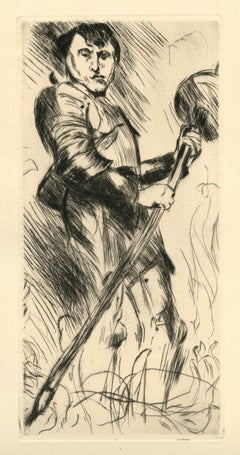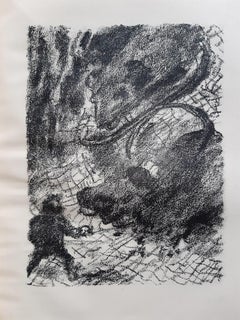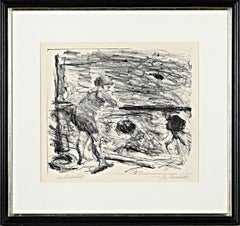Items Similar to William Tell And His Son In Front Of The Hat
Want more images or videos?
Request additional images or videos from the seller
1 of 4
Lovis CorinthWilliam Tell And His Son In Front Of The Hat1923-5
1923-5
$880
$1,10020% Off
£670.82
£838.5320% Off
€766.36
€957.9520% Off
CA$1,238.28
CA$1,547.8620% Off
A$1,356.31
A$1,695.3820% Off
CHF 714.09
CHF 892.6220% Off
MX$16,187.05
MX$20,233.8120% Off
NOK 9,100.50
NOK 11,375.6220% Off
SEK 8,319.23
SEK 10,399.0320% Off
DKK 5,726.78
DKK 7,158.4720% Off
About the Item
LOVIS CORINTH (German 1858 -1925)
TELL AND HIS SON IN FRONT OF THE HAT "(Wilhelm) Tell Und Sein Sohn Vor Dem Hut" 1923 -5, (Muller 781) Lithograph with coloring, signed in pencil. This is one of 25, signed, on Japan paper Total edition 200. Image 9 1/8 x 7 1/4 inches. Full Sheet 15 x 11 1/2 inches with deckle edge. In good condition.
From the portfolio "William Tell". A portfolio of 13 signed lithographs including the title page. Published in 1925. Publisher Karl Nierendorf, Berlin, Printer:A. Rogall, Berlin. (Müller 775-787 - this is the 7th one. There are 25, signed, on Japan paper as offered, Total edition 200, including 75, signed, on "Bütten" paper and 100, signed, on copperplate printing paper)
Below is from the Museum of Modern Art:
Heather Hess, German Expressionist Digital Archive Project, German Expressionism: Works from the Collection. 2011.
Lovis Corinth often cloaked allusions to contemporary politics in historical dress. In these thirteen lithographs for an illustrated edition of Friedrich Schiller's play Wilhelm Tell (William Tell), Corinth addressed individual freedom and political rebellion—highly relevant issues in the tumultuous years following the end of the German empire—through the legend of the Swiss national hero who fought against tyranny. The prints are typical of Corinth's late expressive style, in which he sacrificed figurative legibility for emotional drama. His rapid, sketchy approach in Der Tell-Schuss (Tell's shot), for example, underscores the urgency of the famous moment when Tell must shoot an apple off his son's head for failing to pay homage to a symbol of the emperor. The image, a blur of warm, exuberant color, conveys the swirling rush of fear, anger, and determination that focused Tell's resolve to save his child and take revenge on the unjust ruler.
Corinth knew Schiller's play well. His father had given him a copy for his twelfth birthday. The artist had passed that copy down to his own son, Thomas, in 1914, and he consulted it when making these prints after visiting Switzerland in 1923.
- Creator:Lovis Corinth (1858 - 1925, German)
- Creation Year:1923-5
- Dimensions:Height: 9.125 in (23.18 cm)Width: 7.25 in (18.42 cm)
- Medium:
- Movement & Style:
- Period:
- Condition:
- Gallery Location:Santa Monica, CA
- Reference Number:1stDibs: LU411310534442
Lovis Corinth
Lovis Corinth was a German artist and writer whose mature work as a painter and printmaker realized a synthesis of impressionism and expressionism, known for his dramatic figurative and landscape paintings also for his landscapes of the Walchensee area of Bavaria and his portraits, Corinth also painted religious scenes, often violent . He also made etchings and lithographs in which he revealed his capacity for Expressionist power.
About the Seller
5.0
Recognized Seller
These prestigious sellers are industry leaders and represent the highest echelon for item quality and design.
Gold Seller
Premium sellers maintaining a 4.3+ rating and 24-hour response times
Established in 1977
1stDibs seller since 2016
299 sales on 1stDibs
Typical response time: 1 hour
Associations
International Fine Print Dealers Association
- ShippingRetrieving quote...Shipping from: Santa Monica, CA
- Return Policy
More From This Seller
View AllAUS DEM TIERGARTEN
By Lovis Corinth
Located in Santa Monica, CA
LOVIS CORINTH (1858-1925)
AUS DEM TIERGARTEN 1920 (Schwartz 397)
Drypoint, signed and numbered 47/50. BEAUTIFUL IMPRESSION with RICH DRYPOINT. Plate 9 ½ x 12 ½ inches. Full margins...
Category
1920s Impressionist Prints and Multiples
Materials
Drypoint
EVENING (SELF PORTRAIT with the Battenbergs)
By Max Beckmann
Located in Santa Monica, CA
MAX BECKMANN (German 1884 - 1950)
EVENING (Self-Portrait with the Battenbergs) 1916, (Hofmaier 90: Gallwitz 67)
Etching and drypoint, Plate 10 from the portfolio Gesichter (Faces)...
Category
1910s Expressionist Figurative Prints
Materials
Drypoint, Etching
HAMBURGER KNIEPPE
By Käthe Kollwitz
Located in Santa Monica, CA
KATHE KOLLWITZ (1867-1945)
HAMBURGER KNIEPPE, 1901) (K.58 IIIb)
Soft Ground Etching, Plate 9 ¾ x 8 ¼ sheet 10 ½ x 13 ¾. With the von de Becke blind stamp in the lower right. Prin...
Category
Early 1900s Expressionist Interior Prints
Materials
Etching
Maternité / Motherhood I: Honte / Disgrace
By Marc Chagall
Located in Santa Monica, CA
MARC CHAGALL (1887 – 1985)
MATERNITE, 1926. Motherhood I: Honte / Disgrace (Kornfeld 65, Cramer 5, Sorlier, p. 20-21
Etching, Frontispiece from Maternite Au Sans Pareil, Paris, 1926. Marcel Arland, illustrated by Marc Chagall with five original etchings this being one of the five. Image size: 5 5/8 x 4 1/8. 1130 unsigned impressions on various papers. The story begins with a young woman being shunned by the whole village because she had given birth to a child and left its dead body...
Category
1920s Modern Figurative Prints
Materials
Etching
DER SCHATTEN II - Rich Drypoint - 1st State
By Max Pechstein
Located in Santa Monica, CA
MAX PECHSTEIN (1881 -1955)
DER SCHATTEN II 1918 (Knupp 79, Fecher 143 I/ii)
Rich drypoint, signed and annotated, FIRST STATE. Image: 8 1/4 x 6 inches on japan paper; 15 x 11 1/4 i...
Category
1910s Expressionist Figurative Prints
Materials
Drypoint
SELF PORTRAIT IN A GERMAN MANNER - Large Monotype
By Karl Schrag
Located in Santa Monica, CA
KARL SCHRAG (German - American 1912 - 1995)
SELF PORTRAIT IN THE GERMAN MANNER, 1991
Monotype, Signed titled, dated and annotated "Monotype with touches of Oil color, I /I"
Plate an...
Category
1990s American Modern Figurative Prints
Materials
Monotype
You May Also Like
Rudolf v. Rittner as Florian Geyer - Last man standing -
By Lovis Corinth
Located in Berlin, DE
Lovis Corinth (1858 Tapiau - 1925 Zandvoort), Rudolf von Rittner as Florian Geyer, 1924 (Müller 854), drypoint signed in pencil. 20.4 × 14.2 (plate size), 37.7 × 30.6 cm (sheet size). Published by Karl Nierendorf, Berlin. Framed in a passepartout.
- Strong, precise impression. Frame a little bit rubbed and with two small damages.
About the artwork
The knight is a leitmotif in Lovis Corinth's work, culminating in his Self-Portrait in Armour of 1914. Of all the paintings on this theme, Corinth most often depicted Florian Geyer. Descended from a Franconian noble family, he fought for the freedom of the peasants during the peasant wars of the Reformation, first diplomatically and then militarily, leading the legendary Schwarzen Haufen (Black Troops). The name derives from the black uniforms with which Geyer dressed the peasants willing to fight.
During the Napoleonic occupation, the freedom fighter Florian Geyer was sung about by the Romantics, and the free corps Die Schwarze Schaar, founded in 1813 by Major von Lützow, succeeded the Schwarzer Haufen. It was against this historical background that Gerhard Hauptmann wrote the revolutionary drama Florian Geyer, which premiered at the Deutsches Theater in Berlin in 1896. While the actor Rudolf Rittner, who would later appear in Fritz Lang's films, initially played the role of Schäferhans, he took over the leading role in the new production at Berlin's Lessing Theatre in 1904, again directed by Emil Lessing, which established his fame as an actor. Hauptmann himself praised the acting. He wrote to Hugo von Hofmannsthal: "It went quite well with Florian Geyer. In any case, I had the great pleasure of seeing the play again in an admirable performance". And Lovis Corinth was so taken with Rittner's performance that he painted an oil portrait of him in the role of Florian Geyer in 1906.
After two further graphic versions in 1915 and 1920/21, Corinth returned to the painting a year before his death and almost twenty years after the oil painting to create this graphic version in 1924. Even the inscription in the picture was taken over. This proves all the more the importance of the knight and freedom fighter for Corinth's self-image.
The oil painting, in particular, proclaims the single-minded determination to fight to the last for the values defended, manifested in the oil painting by the tattered flag held out to the enemy. There is a parallel with Rainer Maria Rilke's 1899 story The Cornet, in which the protagonist goes down with the flag that he first saved at the risk of his life.
Consequently, the portrait is also a self-portrait, and the knight's armour is not an academic costume or an ironic refraction, but an expression of Corinth's self-image, which also includes his self-representation as an artist. The Secession poster...
Category
1920s Expressionist Figurative Prints
Materials
Etching
"Der Heilige Georg" original etching
By Lovis Corinth
Located in Henderson, NV
Medium: original etching and drypoint. The English translation of the German title is "The Hug". Published in Leipzig, Germany by Zeitschrift fur bildende Kunst in 1915. The plate me...
Category
1910s Prints and Multiples
Materials
Etching
Gullivers Reise - Rare Book Illustrated by Lovis Corinth - 1922
By Lovis Corinth
Located in Roma, IT
Gullivers Reise is an original modern rare book written by Jonathan Swift (Dublin, 1667 – Dublin, 1745) and illustrated by Lovis Corinth (21 July 1858 –...
Category
1920s Expressionist More Art
Materials
Paper
Lovis Corinth, Badeanstalt 1920, Lithograph, Hand-Signed , German Impressionist
By Lovis Corinth
Located in Eltville am Rhein, DE
Lovis Corinth
Tapiau 1858 - 1925 Zandvoort
Bathing Establishment, 1920
Lithograph on handmade paper
Signed in pencil lower right
Marked "Probedruck" (proof print) lower left
Image size: 32 x 36.8 cm
Frame: 57 x 60 cm
Good original condition, under passe-partout (additional photos available upon request)
Rare proof print prior to the original edition of 115 copies
Published by Fritz Gurlitt, Berlin
Catalogue raisonné Schwarz 442
Handcrafted model frame, museum glass
Viewing and pickup possible by appointment
Authenticity confirmed in writing.
Lovis Corinth was born on July 21, 1858, in the town of Tapiau in East Prussia (now Gwardejsk, Russia). While attending high school in Königsberg, he developed an interest in Greek and Roman mythology as well as the Christian stories of the Bible. From 1876, Lovis Corinth attended the art academy in Königsberg, where he studied under Otto Günther, who introduced him to Weimar plein air painting. In 1880, he transferred to the Munich Academy. Works from his Munich period demonstrate his orientation towards the naturalistic painting style of Wilhelm Leibl's circle.
In 1883, Lovis Corinth traveled to Italy with his father, and in 1884 he spent three months in Antwerp, where he took painting lessons from Paul Eugène Gorge. From 1884 to 1887, Corinth studied at the Académie Julian in Paris. The artist then traveled to Berlin, where he probably painted his first self-portrait in 1887/88, which was followed by numerous others over the years.
From 1891 to 1899, Corinth lived as a freelance painter in Munich, where he belonged to the Secession. After meeting Max Liebermann and Walter Leistikow in the winter of 1898/99, he decided to move to Berlin, where he settled in 1901. Prior to this, his work "Salomé with the Head of John the Baptist...
Category
1920s Impressionist Figurative Prints
Materials
Lithograph
Tod und Jungling - Lithograph by L. Corinth - 1921
By Lovis Corinth
Located in Roma, IT
Tod und Jungling is an original lithograph, realized by Lovis Corinth in 1921, hand-signed and numbered n°33/95.
Included a wooden frame.
In very good conditions.
Here the artworks represented a man with a strong expression of lines drawn, who has caught with his hand a skeleton, interestingly the skeleton has a sense of fear although the man is free of any frightening emotions.
Lovis Corinth (1858-1925) was a German artist and writer whose mature work as a painter and printmaker realized a synthesis of impressionism and expressionism. known for his dramatic figurative...
Category
1920s Figurative Prints
Materials
Lithograph
Don Quixote Observing - Etching by Wladyslaw Jahl - 1951
Located in Roma, IT
Don Quixote Observing is an etching and drypoint print on ivory-colored Japanese paper, realized by Wladyslaw Jahl in 1951.
It belongs to a limited edition of 125 specimens.
Good c...
Category
1950s Contemporary Figurative Prints
Materials
Etching
$224 Sale Price
24% Off
More Ways To Browse
William And Son
Antique Hut
Keith Haring Catalog
Lee Miller
Marcel Broodthaers
Murakami Screen Print
Picasso Chevre
Raphael Soyer On Sale
Romero Britto On Sale
Salvador Dali 1968
Salvador Dali Woman
Signed Mr Brainwash
Vintage Crawling Baby
Woodblock Print Yoshitoshi
Aneta Szoltis Mencina
Aristide Bruant
Blanes Vintage
G Albert

